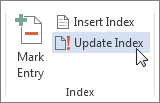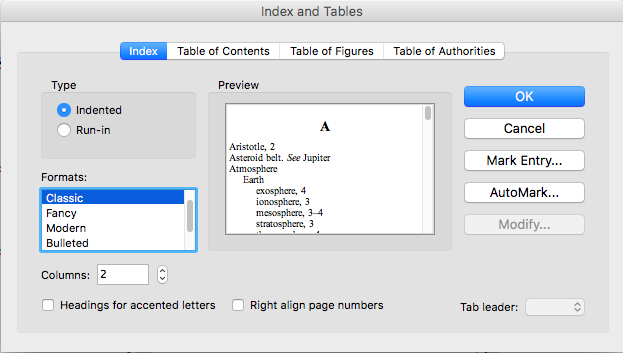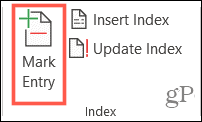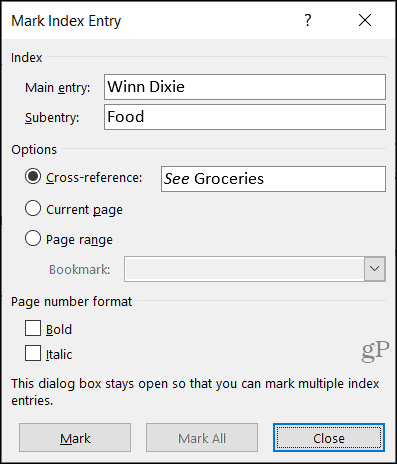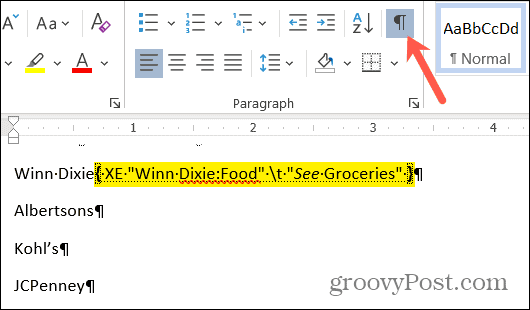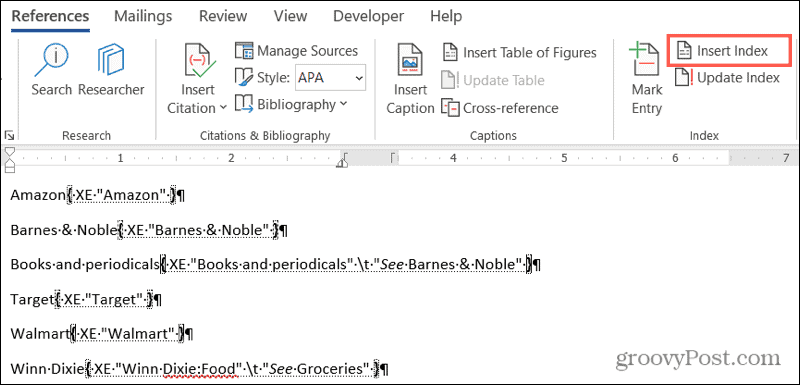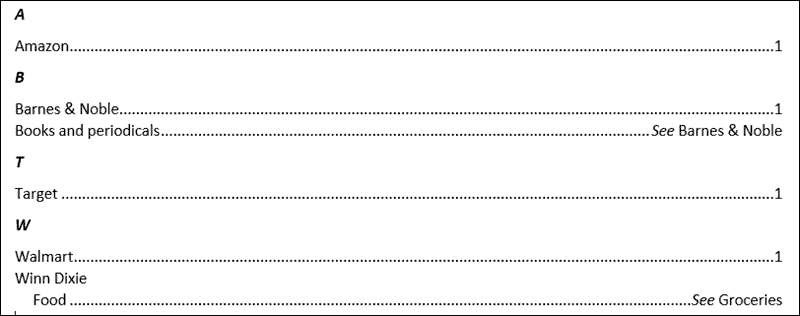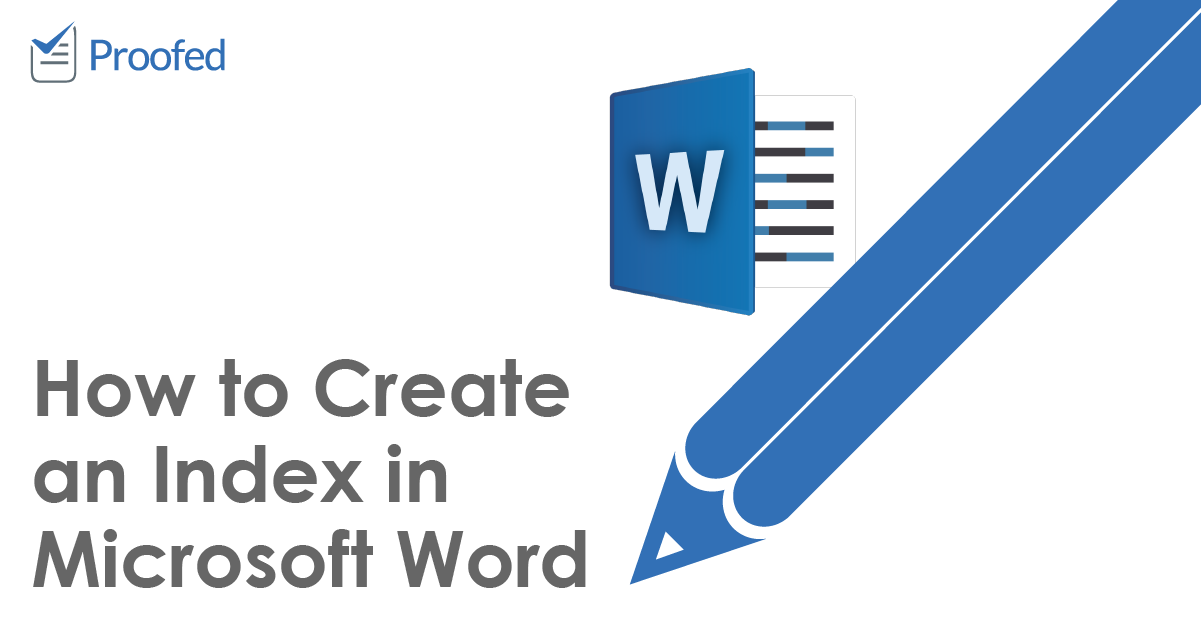We’re going to talk about creating indexes in Microsoft Word. ‘Real’ books often have an index at the back which Word can create for you.
An index is a list of terms or topics that can be found within the document. Microsoft Word has the ‘fixings’ to make an index and automatic options to take some of the drudgery

These days, indexes aren’t as common as they once were. Online documents (in Word format, web pages or PDF) can be easily searched using Ctrl + F, making an index less needed.
Indexes still have a place, especially in printed books. Unfortunately, creating an index in Microsoft Word can be difficult and time-consuming to do on a large scale. This isn’t a slight against Word whose features are mostly adequate, but rather a testament to a conceptually difficult process that needs human judgement. There are professional indexers for a reason.
Hence this series in Office for Mere Mortals, starting this week with the basics; setting up a document to be indexed and then making a simple index.
Word’s Indexing features have barely changed in well over twenty years! Some button positions have moved but the core technology, field codes and shortcut are the same as in Word 6 from 1993.
Indexing in Word – the overview
In short, here’s how indexing works in Word.
Entries are created by selecting parts of the text and adding an Index Entry. They are hidden from normal views of the document but do show up with the right settings.
This is an Index Entry {XE} for the term ‘Sherlock Holmes’.

The Index itself is made by Word which compiles all the {XE} entries into a list like this:

The {XE} we added above, appears in the Index as a reference to page 1 in the text.
Word has some dialog boxes to make formatting the index easy but underneath that is a field code.

Don’t panic … we’ll explain all this as we go along.
Preparing your first Index
Before jumping in at the deep end, we recommend that you first create a copy of your document (or another smaller document) to practice upon without having to worry about messing up the real thing. A file with a large index can get extremely complicated and confusing if you’re not certain about what you’re doing.
When you have grasped both the fundamental and, perhaps, more complex indexing techniques, come up with a method that suits your needs, then you can transfer your knowledge onto the real document without any problems.
Creating an index for an existing document involves two distinct steps:
- marking index entries
- generating the index
Making or marking a simple Index Entry
An index entry is a Microsoft Word “field code” that marks specific text for inclusion in an index. When you mark text as an index entry, Word inserts an { XE “Index Entry” } field formatted as hidden text.
To use existing document text as an index entry, first select a word or phrase that you wish to include in your index or just place the cursor at the right-place in the document. To enter your own text as an index entry instead, simply click where you want to insert it.
Use the Alt + Shift + X keyboard shortcut to insert index entries.
On the ribbon, go to “Reference | Index | Mark Entry” to bring up the “Mark Index Entry” dialog box.

The Mark Index Entry dialog box provides “Main entry” and “Subentry” boxes.
Main Entry
Most terms will fall under the “Main entry” category – a single term with its corresponding page number(s). The selected text is automatically inserted but you can change that, and often will.
Sub-entry
Or use the “Main entry” as a general heading or category for a collection of other terms otherwise known as subentries. For example, the main index entry “Animals” could have subentries “Birds” and “Mammals” – each which would be entered separately.
Here we’ve given Dr Watson a sub-entry for his weapon of choice.

Which appears in the index like this, below and usually indented from the main entry.

Add a few index entries then you’re ready to make your first index.
A short aside for our Mac friends. According to Microsoft’s documentation, Word for Mac doesn’t have ANY in-built shortcut for Mark Index entry. No we could not beleive it either so we dug a little deeper.
There is an in-built Mark Index Entry shortcut Command + Option + Shift + X. It’s listed at Tools | Customize Keyboard.
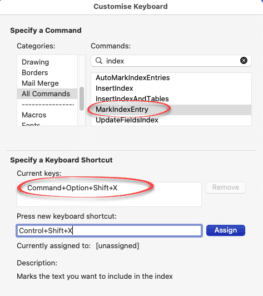
If you think that shortcut is clumsy (we do), try changing it to Control + Shift + X . That’s the closest we could get to the Winword shortcut (Alt+Shift+X isn’t possible in Word for Mac).
Show all
After marking an index entry, you will notice that the show hidden text and show all character options have both been enabled by Word. That’s so you can see and find index entries.

{XE} is the Word field code for Index Entry.
In the double-quotes is the index label. Each sub-level is separated by a colon e.g. “Dr Watson:Revolver” is the Main and Sub entry.
b is the switch to add Bold formatting to that index entry. We’ll look at other switches later.
Create a simple Index in Word
Now there’s a few index entries in the document, let’s make an index from them.
Click the cursor at the end of your document (or wherever you want your index to appear), then navigate to “Reference | Index | Insert Index”
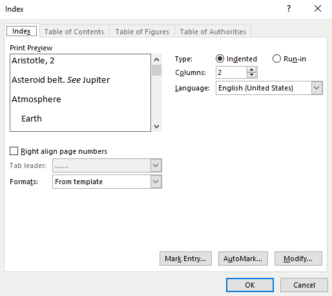
The Index dialog gives you a number of formatting options. The current formatting settings are displayed in the “Preview” pane.
Type: Indented or Run-in
The “Type” radio-button allows you to specify either an “Indented” or “Run-in” type of hierarchical display. You’ve already seen the common Indented index, here’s the run-in alternative:

Run-in takes less vertical space than Indented.
Columns
Another way to save space with an index is adding columns.
The “Columns” box allows you to specify the number of columns that the index will be displayed on per page. It’s much the same as Word’s normal multi-column support but lacks some of the column formatting choices.

The columns can be adjusted from the ruler. If you want better column control (like vertical lines between columns), try inserting multiple columns from the Layout tab then putting a single column index inside the multi-column section.
Right align page numbers
“Right align page numbers” checkbox gives more of a “Table of Contents” look to the index.
Tab leader are the characters between the entry and page number, they guide the eye along the line.

Index Formats
The “Formats” drop down box gives you a number of pre-defined styles to choose from that can be seen in the preview pane. The available styles haven’t changed much over the years, in Word 365 are:
- From template
- Classic
- Fancy
- Modern
- Bulleted
- Formal
- Simple
To design a custom style click the “Modify” button, choose a style and customize as you see fit.
When you are happy with your index layout as it appears in the preview pane, click the “OK” button and your index will be displayed in all its glory.
If you have made any changes to your index entries, always remember to click anywhere on your index and press F9 for those changes to appear in the index itself. Or right-click then Update Field.
That’s enough to get you started. In future articles we’ll look at the many hidden options in Word’s indexing plus some of its shortcomings.
Outlook is stopping Windows Indexing and how to fix it
How to STOP a specific document from being searched / indexed?
Match and Index lookup in Excel
Word for Microsoft 365 Word 2021 Word 2019 Word 2016 Word 2013 Word 2010 Word 2007 More…Less
An index lists the terms and topics that are discussed in a document, along with the pages that they appear on. To create an index, you mark the index entries by providing the name of the main entry and the cross-reference in your document, and then you build the index.
You can create an index entry for an individual word, phrase, or symbol, for a topic that spans a range of pages, or that refers to another entry, such as «Transportation. See Bicycles.» When you select text and mark it as an index entry, Word adds a special XE (Index Entry) field that includes the marked main entry and any cross-reference information that you choose to include.

After you mark all the index entries, you choose an index design and build the finished index. Word collects the index entries, sorts them alphabetically, references their page numbers, finds and removes duplicate entries from the same page, and displays the index in the document.
Mark the entries
These steps show you how to mark words or phrases for your index, but you can also Mark index entries for text that spans a range of pages.
-
Select the text you’d like to use as an index entry, or just click where you want to insert the entry.
-
On the References tab, in the Index group, click Mark Entry.
-
You can edit the text in the Mark Index Entry dialog box.
-
You can add a second-level in the Subentry box. If you need a third level, follow the subentry text with a colon.
-
To create a cross-reference to another entry, click Cross-reference under Options, and then type the text for the other entry in the box.
-
To format the page numbers that will appear in the index, select the Bold check box or Italic check box below Page number format.
-
-
Click Mark to mark the index entry. To mark this text everywhere it shows up in the document, click Mark All.
-
To mark additional index entries, select the text, click in the Mark Index Entry dialog box, and then repeat steps 3 and 4.
Create the index
After you mark the entries, you’re ready to insert the index into your document.
-
Click where you want to add the index.
-
On the References tab, in the Index group, click Insert Index.
-
In the Index dialog box, you can choose the format for text entries, page numbers, tabs, and leader characters.
-
You can change the overall look of the index by choosing from the Formats dropdown menu. A preview is displayed in the window to the top left.
-
Click OK.
Edit or format an index entry and update the index
If you mark more entries after creating your index, you’ll need to update the index to see them.
-
If you don’t see the XE fields, click Show/Hide
in the Paragraph group on the Home tab.
-
Find the XE field for the entry that you want to change, for example, { XE «Callisto» t «See Moons» }.
-
To edit or format an index entry, change the text inside the quotation marks.
-
To update the index, click the index, and then press F9. Or click Update Index in the Index group on the References tab.
If you find an error in the index, locate the index entry that you want to change, make the change, and then update the index.
Delete an index entry and update the index
-
Select the entire index entry field, including the braces ({}), and then press DELETE.
If you don’t see the XE fields, click Show/Hide
in the Paragraph group on the Home tab.
-
To update the index, click the index, and then press F9. Or click Update Index in the Index group on the References tab.
Need more help?
In this post, I’ll share how to build a dynamic Microsoft Word index (i.e. one you can update automatically without having to rebuild it) using 2 methods — the Mark and Index method and using a concordance file.
A Word Index (example shown below) provides a very useful reference for the reader.
Unlike a structured table of contents where the reader scans a general list of topics until they find a one of interest), a Word index allows the reader to search for a specific word or phrase, normally in alphabetical order and go straight to the relevant page (or pages).
How to create a table of contents in Word that updates itself
How to set up multilevel numbering that works perfectly first time
1. Creating a Word Index using Mark & Index
There are two steps for generating an index. Firstly, you must work through your document and ‘mark’ anything that you would like to include in the index. Then, you compile the index, using the marked entries.
Each time you mark an entry, an XE field code is inserted into the document, like this:
{ XE “index entry text” }
XE stands for Index Entry.
Word switches hidden formatting on as soon as you mark an entry so it doesn’t take long before your document starts to look messy. But don’t worry — when you print your document, field codes are not printed.
But don’t worry — when you print your document, the field codes are not printed.
As your Word index grows, It can sometimes be quite hard to locate and isolate a particular index entry to modify or remove it.
For this reason, many editors use a concordance file, which is a table in a separate document that lists everything to be indexed. This file can then be used to compile the index, leaving the original file squeaky clean and making maintenance easy.
(a) Marking a main entry
To mark an entry:
1. Highlight the text that should appear in the index.
2. In Word, select the References tab.
3. Click the Mark Entry icon in the Index group
The Mark Index Entry dialog box is displayed. The text that you highlighted is displayed in the Main Entry box. This is the text that will appear in the index. You can modify it if you wish.
It’s worth learning the keyboard shortcut for marking entries, as you will probably use it a lot when working with large documents. To display the Mark Index Entry dialog box, press
ALT + SHIFT + X
4. Click the Mark button to mark only this occurrence of the word or phrase
Click the Mark All button to flag every occurrence of the word or phrase within the document.
5. Rinse and repeat for each word or phrase you want to include in the index. To save time, you can leave the Mark Index Entry dialog box open – you don’t need to close it for every entry you select a new entry.
An XE field code is inserted into the document
{ XE “index entry text” }
The text within the quotation marks is what appears in the index. It does not have to be the same as the text in the document so you can edit it if you wish.
* Guidelines for marking index entries in Word *
- Spell out abbreviations, e.g. CPU (Central Processing Unit).
- Simplify words or phrases, e.g. change ‘legalities’ to ‘law’.
- Avoid multiple entries of the same keyword, e.g. installing, installations, install procedures. Instead, use one entry – “Install” and list the others as sub-entries (discussed shortly).
- Avoid starting an entry with a vague or ambiguous word, e.g. ‘using’ or ‘to’ or an adjective, e.g. use ‘contact’ rather than ‘multiple contacts’.
- Indexing is case sensitive
(b) Marking a subentry
Subentries are a powerful way of grouping similar items in an index. Let’s say we wanted to index various sub-entries around the main word Console:
- 3DS console
- Switch console
- Game Boy console
If the reader searches the index for Console, they can be redirected to the page(s) for the specific console they are interested in.
In this example, the Main Entry is Console and the 3 subentries are 3DS, Switch and Game Boy.
1. Find the word 3DS in the text and select it.
2. Press Alt+ Shift + X
3. Enter ‘Console‘ into the Main Entry and ‘3DS‘ into the Subentry. Entries will appear in the index exactly as you type them so take care not to misspell anything and be consistent with upper case and lower case.
4. Click the Mark or Mark
All buttons.
(c) Cross-referencing another indexed item
Cross-references are used to direct someone who is searching for one thing to another. For example, if someone searches for Music, the index could say See Audio, or if someone searches for Food, the index could point them towards Nutrition.
Index cross-references should not be confused with the standard Word cross-reference feature which can be found on the Insert menu.
To create an index cross-reference:
1. Select the text to be marked.
2. Press ALT + SHIFT + X
3. Confirm the text in the Main Entry box.
4. Select the Cross-Reference radio button.
5. After “See” type the synonymous text item.
(d) Compile the Word Index
Now that all the entries have been marked it is time to create the index itself.
1. Select the References tab.
2. Click the Insert Index icon in the Index group. The Index dialog is displayed.
3. Choose a Format from the drop-down list. Be aware that different formats select, deselect or change some of the other options in the dialog. The safest approach is to start at the bottom left and work upwards, then to the right.
4. Ensure that Right-align page numbers is selected.
5. Select a tab leader (the tab leader fills the gap between the end of the item and the page number — dots work best).
6. Choose whether to use Run-In or Indent (watch the preview).
7. Choose how many columns to display in the index.
8. Click OK
(e) Update the index (whenever needed)
1. MIn the document, mark any new text you wish to include in the index and remove any existing XE field codes that you no longer require.
2. Click anywhere on the index to show grey shading.
3. Press F9 to refresh the index.
Alternatively, right-click and choose Update Field from the context menu or click the Update Index button on the References ribbon).
How to create a table of contents in Word that updates itself
2. How to remove all field codes from a document
Ideally, a document should be finished before creating an index, but if significant changes have occurred you may want to clear any XE field codes throughout the document and start from scratch. Here’s a simple process to get that job done.
1. Press CTRL H to display the Replace dialog. Alternatively, click the Find & Select icon on the far-right side of the Home ribbon, then choose Replace.
2. In the Find box, type ^d (press SHIFT 6 to get ^).
3. Leave the Replace box empty.
4. Click Replace All (or Find then Replace to process one by one).
Using ^d will remove every field in the document, not just the XE field codes. It is a special character that finds braces (curly brackets) that enclose field codes.
To remove just the XE field codes, use ^d XE.
3. How to create a Word index using a concordance file
Many editors use a concordance file to generate an index for a document. A concordance file is a two-column table that is created in a separate document.
- The left column contains the entries to be marked in the document.
- The right column defines what appears in the index.
- If a text item is separated with a colon then the first part is the main entry and the second part is a sub entry (as pictured in the blue section below).
- Concordance entries are case sensitive, so if a word appears capitalised and not capitalised at various points through the document, create two entries, one for each case variation in the left-hand column, and a common variation in the right-hand column (as pictured in the yellow section below).
- The concordance also provides a good opportunity to handle singles, duplicates and other word variations. Place all the variations in the left column and a common entry for each in the right column (as pictured in the grey section below).
(a) Mark entries within a Word document using the pre-prepared concordance file
1. Select the References tab.
2. Click the Insert Index icon in the Index group.
3. Click the AutoMark.. button.
4. Locate and select the concordance file and click OK . All entries are now marked.
(b) Create the index
1. Select References | Insert Index again.
2. Set your index preferences as discussed in Step 2: Compiling the index (above).
3. Click OK.
(c) Update the concordance and/or index
1. Open the concordance file, make your changes and save the file.
2. Clear the current XE codes in the main document (as described previously).
3. Select References | Insert Index | Automark.
4. Click on the existing index to display the grey shading.
5. Press F9 to refresh the index.
Alternatively, right-click and choose Update Field from the context menu or click the Update Index button on the References ribbon).
4. Key Takeaways
- To create a back-of-book index, text entries should first be marked. The index is then built from the list of marked entries. The index tools are located in the Index group on the References ribbon.
- Entries may be marked once or every time they appear in the document.
- Marked entries have a field code, e.g. { XE «Text to appear in index» } inserted directly after them.
- Field codes are only visible while displaying hidden formatting. They are not printed.
- Press Alt + Shift + X to display the Mark Index Entry dialog box.
- The Mark Index Entry dialog can be left open allowing you to switch between it and the document to mark multiple entries.
- A main index entry may have a number of sub entries.
- An index entry may cross-reference another index entry, if it is a similar item.
- An index may also be created using a concordance file, which is accessed by clicking the AutoMark… button in the Mark Index Entry dialog box.
And that, my friend, is how you build an index page in Word.
How to set up multilevel numbering that works perfectly first time
I hope you found plenty of value in this post. I’d love to hear your biggest takeaway in the comments below together with any questions you may have.
Have a fantastic day.
About the author
Jason Morrell
Jason loves to simplify the hard stuff, cut the fluff and share what actually works. Things that make a difference. Things that slash hours from your daily work tasks. He runs a software training business in Queensland, Australia, lives on the Gold Coast with his wife and 4 kids and often talks about himself in the third person!
SHARE
I’ve just wrapped up a cookbook index, and while I was putting it together I found myself referring to notes I’d made a while ago for a friend who wanted to do cookbook indexing but didn’t want to invest in indexing software. When I worked in house, I’d prepared several cookbook indexes using only Microsoft Word and figured out, through trial and error, a reasonably efficient system. I figured I’d share my notes here for anyone interested. If you have a client with a specific house style, you might have to adjust the approach a bit.
What follows isn’t a guide for writing a good cookbook index. For that kind of information, I’d suggest “A Piece of Cake? Cookbook Indexing–Basic Guidelines and Resources” by Cynthia D. Bertelsen and Recipes into Type by Joan Whitman and Dolores Simon (relevant excerpt about indexes here). The notes below are just a step-by-step system you can follow to take advantage of Word’s functions when creating a cookbook index even though it ordinarily isn’t a great program to use for indexing.
***
Specialized indexing software is invaluable if you’re indexing most nonfiction titles, but a cookbook index has a straightforward structure that Word can easily accommodate. The key is to keep the following in mind:
- As tempting as it might be to sort as you go along—as indexing software allows you to do—don’t. You’ll have a much easier time if you alphabetize near the end.
- The pages may not be final when you start data entry. Be prepared to adjust your locators if they move around.
- Microsoft Word does not sort letter by letter; you may have to go through your index at the end and tweak the ordering of the entries.
1. Data entry
a) Start with the first recipe. Key in the recipe title verbatim (or copy and paste from a PDF), along with the page range. If the recipe has a photo, add that page number in italics.
Type the title in as it appears if it starts with a descriptor:
Deen’s Buttered Bacon Rolls, 108–9, 109
If the title starts with a main ingredient, state the main ingredient category first, followed by a comma. Keep everything on the same line for now.
chickpeas, Chickpea, Green Onion and Quinoa Salad, 54–55
b) Copy the recipe title and locator (the highlighted part):
chickpeas, Chickpea, Green Onion and Quinoa Salad, 54–55
c) Paste the recipe title and locator after keying in all other main ingredients and broad categories (like “beef,” “fish,” “salads,” “sauces,” etc.) on separate lines:
green onions, Chickpea, Green Onion and Quinoa Salad, 54–55
quinoa, Chickpea, Green Onion and Quinoa Salad, 54–55
salads, Chickpea, Green Onion, and Quinoa Salad, 54–55
d) If the recipe title starts with more than one descriptor, add entries for all possible inversions that readers might look up. Add a special mark like an asterisk, which indicates that this entry could be considered for cutting if space is tight:
Buttered Bacon Rolls, Deen’s, 108–9, 109*
e) Key in any subrecipe titles and page ranges, under an appropriate category if necessary. If the subrecipe title is generic, you may also have to add the full recipe title for clarity. Append a double-asterisk, indicating that this is a subrecipe:
dressing, Special Dressing, for Chickpea, Green Onion and Quinoa Salad, 54–55**
f) Index special ingredients or techniques only if they are defined/discussed in detail. If the book contains many definitions, you may want to indicate these by setting the locators in boldface. Again, append a double-asterisk:
cold smoking, 56, 56–59**
g) Repeat steps 1a to 1e for all recipes in the cookbook, proceeding in order. Apply 1f as needed, as you go along.
h) Add any logical cross-references.
beef. See also veal
i) Run a spell check on the index.
j) Save this file as index_v1.
k) Once the cookbook’s pages have been finalized, confirm locators, making any necessary adjustments. Save index_v1.
2. Structuring
a) Alphabetize: select all, go to Table → Sort… → Sort by paragraphs, ascending.
b) You’ll have lists like these:
beef, Chinese Five-Spice Beef Short Ribs
beef, Curried Beef and Vegetable Skewers
beef, Grilled Garam Masala Burgers
beef, Wine-Marinated Prime Rib Roast
beef. See also veal
Move the general category and any cross-references to the top, then replace the category in all other entries with a tab indent by selecting that segment of text and using Word’s Find and Replace function.
beef. See also veal
Chinese Five-Spice Beef Short Ribs
Curried Beef and Vegetable Skewers
Grilled Garam Masala Burgers
Wine-Marinated Prime Rib Roast
Go through the index and repeat this step for all categories that have two or more subentries.
c) For main ingredient categories that have only one recipe, just invert the recipe name to showcase that ingredient first:
quinoa, Chickpea, Green Onion and Quinoa Salad, 54–55
becomes
Quinoa, Green Onion and Chickpea Salad, 54–55
d) Add line spaces after the end of each section that begins with the same letter. Add group headings “A,” “B,” etc. before each section only if there is enough room.
e) Add a headnote mentioning that photos are referenced in italics and definitions in boldface.
f) Save as index_v2.
3. Cutting to spec and finalizing the index
a) Save as index_v3.
b) If the index is too long, consider first eliminating whole categories that readers are unlikely to look up or that are redundant. For example, if the book itself has a section devoted to desserts, having a dessert category in the index is not needed.
c) If the index is still too long, consider combining some categories and adding cross-references. For example, if you have divided “fish” and “shellfish,” consider combining them under “seafood” and adding cross-references to the new category under both “fish” and “shellfish.” Doing so will allow you to cut duplicates of recipes that include both fish and shellfish.
d) If the index is still too long, consider cutting all subrecipes and special ingredients/techniques, which you’d marked off earlier with double-asterisks.
(If the index needs a lot of cutting and you’re confident you will need to cut all entries marked off with double-asterisks, you can use Word’s Replace function to get rid of all of them at once. If you’re comfortable with wildcard searches, place your cursor at the top of the document, then, in the Replace dialogue box, put [!^13]@**^13 in the “Find what” field and nothing in the “Replace with” field. Make sure “Use wildcards” is checked. Clicking “Replace all” should get rid of any lines that end with a double-asterisk.)
e) If the index is still too long, evaluate for cutting or abridging only those entries that have an asterisk. (Never cut out or modify an entry that matches the recipe title exactly.) If it makes sense to cut the whole entry, do it. You could also cut part of the title if it refers to sauces and garnishes that aren’t a fundamental part of the dish.
f) Delete all the asterisks. (Using the Replace function, put * in the “Find what” field and nothing in the “Replace with” field.)
g) Edit the index as outlined in Chicago 16.133, in particular double-checking alphabetization, then save index_v3 and submit it.
Versioning system
- Index_v1: This version makes it easier to update locators if pages—especially if spreads or larger groups of pages—are moved around.
- Index_v2: Go back to this version if the publisher decides to add pages to allow more room for the index.
- Index_v3: Your final submitted index.
Publishers often ask non-fiction book authors to create an index of their work. Creating an index is a non-trivial task often performed by people who specialize in creating indexes using software designed for that purpose. Adding to the complexity is authors usually work in Microsoft Word while publishers work in Adobe PDF. The PDF generated as a proof will have different page numbers than the original Word document.
If faced with indexing a PDF book, there is a less painful method whose trick is to match the proof PDF page numbers with the Word manuscript and use the indexing features of MS Word.
Create a Word document with the same page numbers (a little tedious)
- Make a copy of the original Word document to use for indexing. Make sure a page number is being shown on each page of this copied document.
- If the PDF has more pages than the Word version, jump to step 4
- If the PDF has fewer pages, reduce the spacing from double space to single space. This will prevent auto-pagination from adding page breaks where you don’t want them
- With the copy opened in Word and the PDF opened, insert page breaks in the Word document in the same places as the PDF Insert, Page Break. Repeat until the Word document has the same page number marking as the PDF.
- The keyboard shortcut for Page Break is fn+Shift+return on Mac and Ctrl-Enter on Windows.
Flag each word/phrase desired in the index (the laborious part)
- Highlight the word or phrase to be indexed
- On the References tab, in the Index group, click Mark Entry.
- Repeat for the whole book including duplicates of word/phrases. The AutoMark feature will help find all entries for word if desired.
Note you can have more complex indexes (subentries, etc.) by marking things appropriately.
Generate the index (the quick part)
- Goto the end of the document (to avoid harming the real page numbers)
- References tab, in the Index group, click Insert Index.
- If you go back and add or change index entries in the document, remember to click Update Index in the Index group on the References tab.
- A variety of formatting options is available.
Provide the index to the publisher
- Open a blank Word document
- Select the generated index and copy it. In the blank Word document, Paste Values to avoid the index being recalculated on a blank document.
- Save and provide this document to the publisher.
Versions of Microsoft Word
The menu commands vary between different version of Word. For example, Word 2008 on Mac uses Insert, Index and Tables to both mark entries and generate the index.
Other Tools
Adobe Acrobat Pro – has an indexing feature but this has nothing to do with book indexs
Google Docs – doesn’t support indexing, only table of contents based on header levels
PDF Index Generator – $70 specialized tool for creating indexes from PDF files
Converting from PDF to Work is not likely to work cleanly due to PDF formatting
I recently published an academic book (Anthropology at the Dawn of the Cold War: The Influence of Foundations, McCarthyism and the CIA, since you asked) and one of the tasks I was responsible for was creating an index for my book. Yes, I could have asked them to send it out to a professional indexer, but that would come out of my royalties — maybe take up all my royalties. Besides, I figured, how hard could it be?
Turns out, very hard. Indexing is not a simple exercise in any way; each entry has to be thoughtful and necessary, the best way to find a specific piece of information. You have to imagine who might use your book and what kind of information they might seek, and then predict how they might seek that information. You have to weigh every keyword — every name, theory, book title, event, place, organization, etc. — to decide whether its use in the text is significant enough to direct people to it. Like I said, it’s hard work, and much more an art than a science. (Incidentally, indexes are copyrighted works, which reflects their status as an original expression of thought.)
In the end, I did the index, and I think I did a pretty good job of it. I started by using index cards (that is their name, after all) but that got old really fast, so I developed my own system using a notepad, Excel, and Word. Here’s how:
- Go through each chapter of proofs, writing down each word you feelcould be in the index, followed by the page(s) on which it appeared. Use a pen and paper for this, and allow plenty of latitude on whether or not a term should end up in the index –you’ll winnow later.
- After an initial pass through the book, make a second pass to catch any terms you don’t decide to include until a later chapter.
- One chapter at a time, copy the word lists into Excel. One column for each keyword, and another for the page numbers (multiple instances separated by paragraphs). For subheadings, put the main heading, followed by a dash, followed by the subheading, like this:
Steward, Julian — as Columbia professor
- After each page is entered, sort on the keyword column. All the subheadings sort together because they share the same first part (the heading).
- As you enter each page, check to see if there is already an entry for each term and add the page numbers to that, or add a new entry at the bottom if this is the first time the term appears. If you make a mistake and add a duplicate, no big deal, because when you sort, the duplicates will end up next to each other and can be easily identified and combined.
- Enter a page, sort, enter a page, sort, and on and on until done.
- Check to see if there are any duplicate entries and combine them: cut and paste the page numbers from one into the other’s entry, and delete the now-empty row.
- Now, edit. For any entry that has more than 5 or 6 page references, consider adding sub-headings. For any entry that has only one or two page references, check to make sure the mention is significant. Review each entry and decide whether it is the best way to find the information it points to. Add cross-references (“Anti-communism, see McCarthyism”; “see also Columbia University”). This is real editing of real writing– you have to be sure that every word adds to the value of the piece, just as you would if this were a novel, short story, or essay.
- Once all the entries are in order and you’re satisfied that your index is both thorough and accurate, copy and paste the two columns into Word. Use “Paste Special” to paste as unformatted text (otherwise it will paste as a table).
- Clean up the formatting, adjust the text size and font, make everything look nice, and you’re done.
Tags: booksindexpublishingwriting
You may also like…
If you’re composing a lengthy document or book, we’ll show you how to create an index in Word. This is a handy reference for your readers.
If you’re creating a lengthy document in Microsoft Word, an index is a convenient tool for your readers. Traditionally, we see indexes in the backs of books. These handy tools allow us to look up a word or phrase to find the page referencing that topic.
Similar to a table of contents in Word, you can insert an index and then update it automatically. This takes much of the manual work out of creating these great reference sources. Here, we’ll show you how to mark your index entries, create the index, and update it in Word.
Mark Your Index Entries
Even though Word can build your index automatically, it’s not smart enough to know which items you want in it. So to create your index, you’ll need to mark the entries. This is the bulk of the work you’ll do for the index. But once you start marking entries, you’ll be able to zip through them quickly.
- Open your document in Word and head to the References tab.
- Select your first index entry by dragging your cursor through it. This can be a word or phrase.
- In the ribbon, you’ll see the Index section toward the right side. Click the Mark Entry button.
- A small pop-up window appears for you to describe your entry. And this window can remain open while you select your remaining entries.
- Enter the Main entry at the top and optionally a Subentry.
- Choose from Options for a cross-reference, the current page, or a page range.
- Optionally, you can format the page number that displays in bold and/or italic.
- Click Mark for a single entry or Mark All to mark that same text everywhere in your document.
- When you finish with the Mark Index Entry window, click Close.
On your document, index entries are labeled with “XE”. If you add a Subentry or cross-reference, you’ll notice that within the XE tag as well. If you don’t see your XE tags but would like to, go to the Home tab and click the Show/Hide Paragraph button.
Edit or Remove Index Entries
If you need to make a change to an entry, for instance, remove a cross-reference, you’ll do so within that XE field. Make your changes inside the quotation marks. Another option is to remove the marked entry and then remark it.
To remove an index entry, select all text within and including the braces ({ }) and hit Delete. You can then follow the steps above to mark the entry again with the changes you want.
When you’re ready to insert your index, move your cursor to the spot you want it in your document. Then, select the References tab and click Insert Index. Before the index is created, you have a few settings you can adjust if you like.
Print Preview: This gives you a snapshot of what the index will look like and it will adjust if you change the below settings.
Tab Leader: Certain formats (below) offer different tab leaders to choose from such as dotted lines or dashes. These come between the entry and the page number.
Formats: You can pick from different themes for your index such as fancy, modern, or formal for a pleasing appearance.
Type: Choose from Indented or Run-in for the format type. You can spot the difference in the Print Preview box.
Columns: Depending on how many entries your index has you may want to add or remove columns for the structure.
After you make your index adjustments, click OK. Your index will pop into your document with your entries. You’ll see everything nice and neat and in alphabetical order.
Update the Index
You can continue to mark additional entries after you create your index and simply update it. And if you edit or remove entries, you’ll need to update the index as well.
Click inside the index area in your document and click the Update Index button in the ribbon on the References tab. If the button is grayed out, be sure your cursor is within the index.
If you want to remove the index completely, select all of its text and hit your Delete key. You’ll then likely want to delete the index entries (above) if you don’t plan to use an index at all.
Create an Index Automatically in Word
It can take some time to mark all of the entries you want in your Word index. But an index can be a valuable tool for your readers. So consider adding one if your audience can benefit from it for your next Word document, book, or other lengthy material.
For more reference features, check out how to cite sources and create a bibliography in Microsoft Word.
Have you ever wondered who compiles the indexes at the end of books? Traditionally, this has been a specialist profession. However, these days, you can add an index to a document yourself. In this post, for example, we’re looking at how to create an index in Microsoft Word.
When to Add an Index
Most documents don’t need an index. In fact, it is usually only book-length non-fiction that does! And even if you are writing a non-fiction book, indexing is often handled by the publisher.
However, if you want to self-publish a work of non-fiction – or if you are creating another long document such as a company handbook – you may want to add an index yourself. And this is where the indexing options in Microsoft Word become very useful. This process involves two steps:
- Marking terms that you want to appear in the index
- Generating the index itself
We’ll now look at how to create an index in more detail below.
How to Mark Entries
Most of the work of creating an index comes with marking text. This means going through the document to look for terms you want to include in the final index. To mark an entry:
Find this useful?
Subscribe to our newsletter and get writing tips from our editors straight to your inbox.
- Use the cursor to select the word/phrase you want to include in the index
- Go to References > Index on the main ribbon and click Mark Entry
- In the new dialogue box, select the options required
- Click Mark to mark the term selected or Mark All to mark every use of the term throughout the document
The options in the Mark Entry dialogue box mentioned above will let you:
- Link a Subentry (i.e., a similar term) to the main term
- Cross-reference a term with another index entry
- Control the page number format
Make sure to do this for every term that you want to include in the index. If you need to “unmark” a term, you will first need to turn on hidden text in Word. You will then be able to see, and if required remove, the index entry in curly brackets. Make sure to do this for all similar entries.
How to Create an Index
Once you have marked your entries, all that’s left is to create an index:
- Place the cursor where you want to create an index
- Go to References > Index and select Insert Index
- Select any required formatting options from the menu
- Click OK to insert an index in the selected location
Microsoft Word will generate an index based on your marked entries. If you change any of the marked entries, you can then update the index at the click of a button by going to References > Index > Update Index.

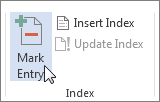
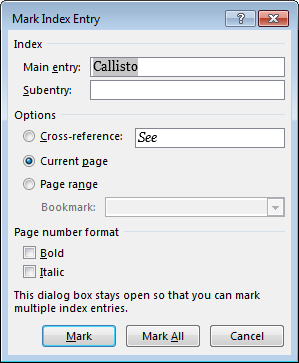
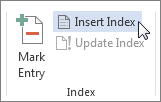
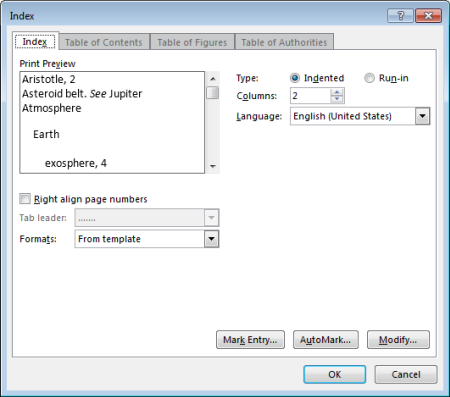
 in the Paragraph group on the Home tab.
in the Paragraph group on the Home tab.